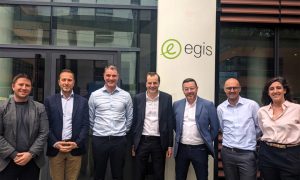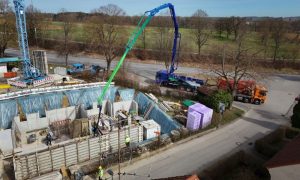Women in Construction: Conductors of Construction
Four PMs talk about challenges they face and steps they take to deal with fast-tracking, constrained budgets and setbacks

To support the drive towards gender balance in the industry, Middle East Consultant and meconstructionnews.com are highlighting female construction professionals in a series of profiles. By telling their stories and sharing their experiences on our print and digital platforms, we hope to inspire more women to join this vibrant industry. Here four PMs talk about challenges they face and steps they take to deal with fast-tracking, constrained budgets and setbacks.
Project managers (PM) are the equivalent of conductors in an orchestra. In the same way that conductors unite the orchestra and shape the final sound, project managers play a critical part in the construction process, regardless of whether the project in question is a small structure, a skyscraper or a mixed-use mega project.
PMs have to work with project owners/clients, contractors and other stakeholders and are ultimately responsible for controlling and delivering projects on schedule and within budget, while maintaining safety and the desired level of quality. Of course, unlike orchestra conductors, PMs don’t really have the opportunity to rehearse the project before getting to work and instead have to rely on their experience and skills to plan, manage the build and deliver the project.
It’s an intensive and gruelling process, and multiple factors can seriously impact a project, particularly in fast-paced and vibrant construction sectors such as those seen in the GCC.
“Time constraints are a reality in all projects. Dividing the entire schedule into small achievable milestones helps to track and ensure that the project is proceeding in the correct direction and at the right pace. Project risk workshops where mitigation and recovery plans are formulated should be carried out regularly to forecast issues potentially leading to delays, so that advance mitigation or alternative plans may be implemented,” explains Lay Kiat Neo, project manager at Faithful+Gould.
Speaking about the importance of clear communications on projects, she says, “Vague instructions can create confusion and a misalignment of expectations between contractors and stakeholders, creating misunderstandings and possible reworks. To avoid miscommunications, I prefer face-to-face conversations (or a phone call at the very least) to explain what is needed. By having these interactions, I can tell from their voice or body language if they understand me and if they will carry out the tasks as required. Understanding the actual time line and commitment level will allow me to better plan the schedule and manage the clients.”
Additionally, she points out that it’s key to have the employer’s requirements right from the start. “These requirements are needed at the beginning of the project, and ideally they should be aligned with the available budget before the commencement of the project. However, it is common that the client’s requirements are fluid and change multiple times during the project. This can impact the overall programme and cost, due to rework.”
“However, this could be minimised if all stakeholders can be identified at the beginning of the project and their requirements are captured, agreed and signed off upon. Intermediate stage approvals for design/construction could also provide opportunities for the stakeholders to see what they will be getting and to provide comments along the way, instead of a flat rejection right at completion, which would be catastrophic!”
Stephanie Bache, programme manager at Parsons, adds, “The first challenge is aligning client and team expectations, which starts in the tender phase and extends through project commissioning. We address this through consistent and clear communication. The second is managing swings in the team’s workload, as projects seem to ramp up and wind down concurrently. We address these swings by phasing work (prioritising tasks with the client) and by communicating among project managers. The third challenge is stakeholder approvals, which throughout our industry is a global challenge, not just in Dubai. We overcome this challenge by building relationships with stakeholders so that the team is aware of changing requirements and can quickly adapt.”
Aiming for 2020
In a bid to capitalise on mega events such as Expo 2020, an increasing number of clients and project owners are fast-tracking projects in Dubai. Sandra Santamarina, senior architect at Godwin Austen Johnson (GAJ), comments, “There is a big push to have many projects here in Dubai finished in time for Expo 2020, but if the timeframe is not viable, it simply won’t happen. Fast-tracking is risky and there are many who believe that such scheduling may actually incur more changes, leading to delays and increased costs of change.”
She notes that some of the risk can be reduced, however: “Planning ahead and setting realistic milestones with reviews along the way can help mitigate costs and delays. By overlapping design and construction so they run simultaneously, the fast-track method can be one of the ways to reduce project time significantly.”
Mariam Kamel, senior project manager at Al Tayer Stocks, agrees and elaborates. “Successful fast-tracking is the result of a proper team approach. Fast-tracking needs the quick turnaround from the design team along with an agile design team who can accept changes to better the timeframes. Fast-tracking also needs the input of an experienced contractor who can flag the risks upfront to enable mitigation, along with the good reputed contractor that has the support of the supply chain. Also, the PM needs to follow up with the client to ensure that any decisions or paperwork are issued in a timely manner.”
Parsons’ Bache agrees with Kamel and Santamarina, saying, “I agree that most current projects seem to be on the fast-track route. Regarding the impacts of fast-tracking, aligning client and team expectations is critical because misunderstandings early on can have ripple effects on the delivery. Doing this involves focused scope meetings at the beginning of the project and developing responsibility matrices to clarify roles.”
“I also like the zipper approach to management, which is where different members of our team interact with client members at different levels in the respective organisations. I find that this effectively expedites information exchange as long as it is coupled with consistent team communication, documentation and control of data.”
Budget Concerns
Constrained project budgets coupled with accelerated timelines means there’s little to no room for error on projects. As a result, PMs have to be at the top of their game to ensure that construction goes to plan. Identifying risks ahead of time is critical, says Faithful+Gould’s Neo.
“For every project, risk management is critical and fundamental to ensure that schedule, cost, quality, etc are monitored and mitigation plans can be formulated in advance, should any risks become an issue. Identifying potential risks ahead of time means that the project team is better prepared and can react faster to a problem because the brainstorming, exploring of various options and formulation of the ideal mitigation/recovery plans have already been done beforehand. Since additional time is not wasted on exploring options during actual problem solving, the time saved would be invaluable in reducing the delay to the project and be better utilised to ensure the quality of the mitigation actions.”
GAJ’s Santamarina points out that constraint budgets are common in the construction landscape. “The key to staying within budget is to understand the intent of the project and bring it to reality from the very first step. Setting realistic project goals and sharpening the scope of your project can prevent major constraints later on. We also need to determine where the money should be spent, and re-evaluating at each of the milestones will allow PMs to assess the allocation and its feasibility.”
Parsons’ Bache says her organisation relies on robust quality assurance and a quality control programme to keep things in check and make sure clients are aware of the repercussions of their decisions. “Regular design updates with the client are critical. The proper documentation of design decisions and changes is part of our quality programme. I believe in maintaining action items and decision logs. Revisiting initial decisions always costs more money and is detrimental to other phases of a project. Clients certainly have the prerogative to change their minds, but they must understand the impact to the project.”
Al Tayer Stocks’ Kamel reveals that the right partners are critical to ensure success when budgets are constrained. “The equation of time, budget and quality is a fine balance and needs a lot of experience to ensure the right output is achieved. It all starts with teaming up with the right partners. ‘Right’ in the sense of experience, financial stability and shared interest in quality and safety. This is followed by developing a detailed and sequenced project programme that gets distributed and followed by all stakeholders. From that programme, and based on team experience, a risk register log is developed and monitored on a weekly basis. This risk is covering both time and cost. The key to succeeding in achieving the balance is consistent monitoring and follow-up.”
Addressing Issues
While PMs are meticulous in their plans and aim to predict or spot problems before they occur, problems are inevitable on active projects. Dealing with them immediately and effectively is of the utmost importance.
Faithful+Gould’s NEO says, “The project team needs to proactively come together and find out the real reason why the problem occurred. Options should then be explored and solutions presented to the client, at the same time advising them of how the various options impact the project. I think it is important not to sugar-coat the issue but to give a true account. Only with a true understanding of the issue can an effective mitigation/recovery plan be advised and implemented to quickly bring the project back on track. However, I think there must first be strong rapport already built between the project team and the stakeholders before true honest communications can take place.”
Finding a solution should be the focus when issues arise, advises Parsons’ Bache. “We focus on solutions, not on blame. If there is an issue, one-on-one discussions with both the client and key team members are necessary to frame and then isolate the problem. Once isolated, our goal is to focus the team on other tasks that can continue unaffected while the problem is solved.”
Al Tayer Stocks’ Kamel warns that emotions should be left out of the equation. “If a problem occurs, it is very important for the team to restrict their emotions and avoid the blame game or finger pointing, because this gets all members on the defensive side and their focus turns to self-preservation rather than problem solving. Most problems during the construction phase can be sorted out by enhanced engineering that can lead to creative solutions.”
Chasing a Moving Target
Changing client requirements are another factor that project managers have to contend with. While this may have once been a rarity, each PM says it’s a given today and that considered action has to be taken to ensure a project stays on track.
“It is not unusual for clients to request changes once the work has started, in fact it is quite normal. Naturally, we have to consider the feasibility and scale to determine whether the changes can be incorporated without jeopardising the design or going off the schedule. A good PM will have the necessary technical knowledge and communication skills to develop strategies to accommodate them and minimise the impact to the time scheduled and keep the project on track,” GAJ’s Santamarina says.
Faithful+Gould’s Neo comments, “Changes during construction are inevitable. Most of the time, project owners know what they don’t want only after they have seen and touched what has been built! Project managers need to understand the changes, assess the associated impacts from the change (cost, programme, quality, outcome) and advise the project owners before implementing the change. Project managers should also provide other options that aims to achieve the new change but at a lesser impact to original programme, cost and quality.”
“Based on the options provided, project owners can then make an informed decision. When the expectations of the project owners have been managed with realistic impacts due to the changes they make at an advanced stage, the project could then be back on track with a mitigated impact.”
Al Tayer Stocks’ Kamel notes: “Client changes are a silent factor that can impact timeframe and quality if not managed properly. Client changes can happen at the beginning of the project, and they are mostly driven from value engineering requirements. Those changes can be accommodated in the initial timeframe of the project, subject that deadlines are created and are followed in the decision-making process.”
“Client changes towards the end of the project are best addressed after the project is fully completed and handed over. They are then treated as day two works – although this may be disruptive to the client operations, it is the best proposal in terms of avoiding extension of times or accepting substandard quality.”
Evolving Roles
The way that PMs work on and deliver projects is evolving, thanks to new technology and innovations such as BIM, AR and VR. Project managers are now able to work on projects remotely through smart devices and can almost instantly communicate and address changes through the use of software.
“Our ever-improving electronic data management systems continue to make information exchange easier for project managers. We have become much more connected to the project with the advent of mobile phones and now smart phones, which allow us to provide direction from across the world. I think these communication devices will continue to improve our ability to manage data and produce deliverables. 3D modelling also helps clients and end users better visualise the future asset,” says Parsons’ Bache.
“As we become more efficient, our teams may get smaller. However, people management will always be part of being a project manager, and the same challenges and rewards will continue to exist.”
Early PM engagement is also beginning to take hold in the region, with significant benefits. Al Tayer Stocks’ Kamel concludes: “Developers and owners who engage PMs early in the project tend to have an accurate budget and a more realistic timeframe for the full project duration. Also, having PMs involved will ensure that the right sequence is followed, which minimises surprises at later stages. For example, if a client wants to rent a new commercial office space to accommodate a certain number of employees, the PM company will advise the client to take the first step before signing the lease. This step will be validation of services and area to ensure that the proposed space will accommodate the desired number of employees. This will save the client both time and money in the event that a full design was done and then [it was] found that the rented space is not suitable.”
To support the drive towards gender balance in the industry, Middle East Consultant and meconstructionnews.com are highlighting female construction professionals in a series of profiles and by gaining from their insight. By telling their stories and sharing their experiences on our print and digital platforms, we hope to inspire more women to join this vibrant industry.















